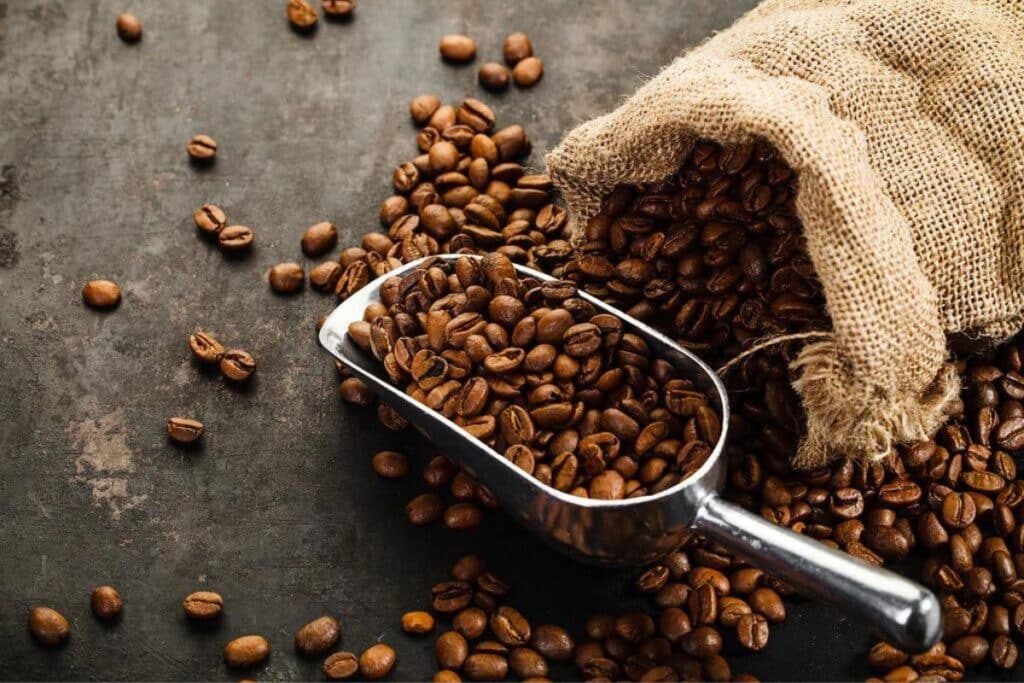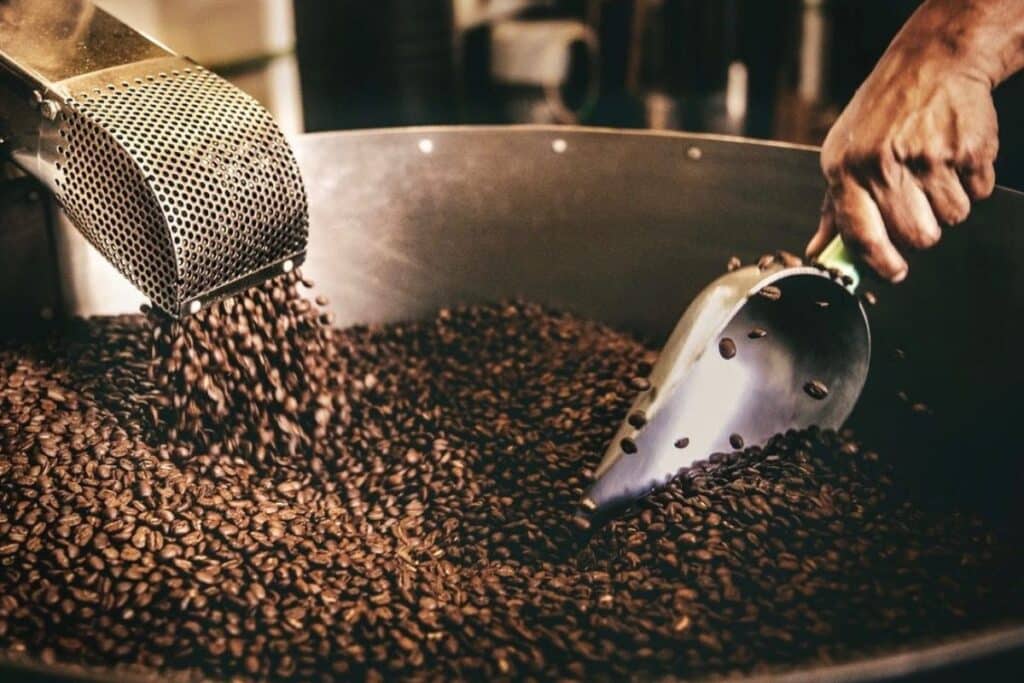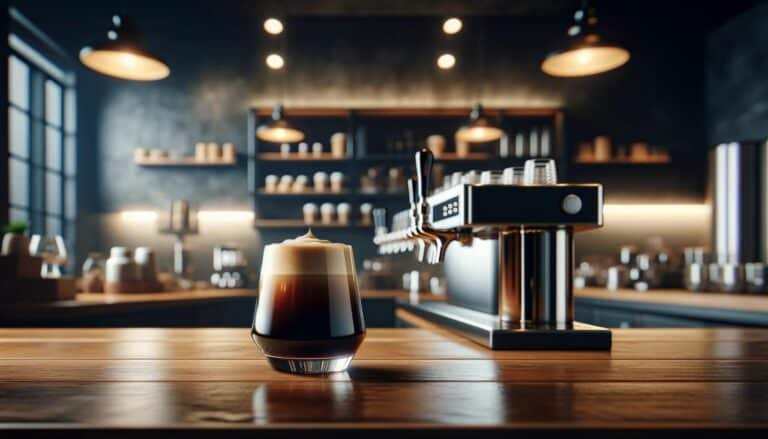Roasting coffee is an essential step that turns green, raw beans into the aromatic, flavorful beans we love to grind and brew. This process uses careful heat application over time to bring out the bean’s color, flavor, and aroma. It’s both an art and a science, needing precise control over temperature and timing to hit the perfect roast level.
“Medium roast” points to a specific spot on the coffee roasting spectrum. It finds the middle ground between the lighter, more acidic tastes of light roasts and the strong, bold flavors of dark roasts. Medium roasts offer a balanced mix of flavor, acidity, and body, letting the bean’s natural taste shine through while adding some flavors from the roasting process. The beans turn a medium brown color and stay oil-free on the surface. They reach an internal temperature usually between 410°F (210°C) and 430°F (221°C). Many coffee lovers prefer this roast level because its versatile flavor fits a variety of brewing methods, making it a favorite choice for both home brewing enthusiasts and professional baristas.
What is a Medium Roast Coffee?
Medium roast coffee offers a balanced flavor profile, with a medium brown color and no oil on the surface of the beans. It preserves the unique characteristics of the coffee’s origin while introducing roasting flavors like caramel and chocolate, with moderate acidity and a fuller body than light roasts. This roast level is versatile, suitable for various brewing methods, and is popular for its appeal to a wide range of coffee drinkers.
The Coffee Roasting Spectrum

Roasting coffee involves heating green coffee beans in a roasting machine, triggering chemical and physical changes that bring out the beans’ flavor, aroma, and color. The process kicks off with the beans getting hot. As their temperature climbs, they go through reactions like the Maillard reaction and caramelization, shaping the coffee’s final flavor. The beans expand, change color, lose moisture, and pick up those delicious roasted flavors. The roaster’s job is to nail the temperature and time to get the roast level just right.
We split the coffee roasting spectrum into three main levels: light, medium, and dark roasts, each with its own unique traits:
- Light Roasts: These beans roast for the least amount of time, stopping usually at the first crack—a moment when the beans pop open from the heat. They’re light brown, not oily, and keep most of their original flavors, packing a punch of acidity. People who love tasting the coffee’s origin flavors often go for light roasts.
- Medium Roasts: Roasters stop these beans after the first crack but before the second. They’re a medium brown, still not oily, and balance flavor, acidity, and body nicely. Medium roasts let the coffee’s natural tastes shine but add a bit of roast flavor, making them a big hit.
- Dark Roasts: These beans roast until they crack a second time. They turn dark brown or nearly black and get oily. The flavors are strong and bold, less acidic but more bitter. The roasting process’s flavors take over, hiding the beans’ original tastes.
Roast levels play a huge role in flavor. Light roasts highlight the bean’s own notes, like floral, fruity, or acidic ones. Medium roasts mix these natural flavors with a touch of roastiness, adding complexity. Dark roasts bring out bold, rich flavors from the roast, like chocolate, nutty, or smoky. Picking the right roast level can make the coffee taste even better, so it’s key for both coffee makers and drinkers to understand the differences in the roasting spectrum.
Characteristics of Medium Roast Coffee

Medium roast coffee occupies a sweet spot in the roasting spectrum, presenting characteristics that many coffee enthusiasts find perfectly balanced. Here’s a closer look at the defining features of medium roast coffee in terms of color, appearance, bean surface oil, and the typical roasting temperature range:
Color and Appearance
- Color: Medium roast beans exhibit a rich, medium brown color. Unlike the lighter shades of light roasts, they present a deeper hue that suggests a fuller flavor without reaching the dark tones of dark roasts.
- Appearance: These beans are more rounded and fuller in size compared to their pre-roasted state, having expanded during roasting. The surface of medium roast beans is matte, lacking the shiny, oily appearance characteristic of dark roasts.
Bean Surface Oil Presence
- Surface Oil: One of the most notable aspects of medium roast coffee is the absence of oil on the bean’s surface. This is because the beans are not roasted long enough for the oils to break through the surface. The lack of oil contributes to a cleaner taste and mouthfeel, allowing the bean’s natural flavors and the subtleties developed during roasting to shine without being overshadowed by the oils.
Typical Roasting Temperature Range
- Roasting Temperature: Medium roast beans are typically roasted to an internal temperature between 410°F (210°C) and 430°F (221°C). This temperature range is critical as it falls after the end of the first crack (an audible signal indicating that the beans have begun to expand and roast) but usually before the second crack begins.
- Roasting Duration: The precise timing within this temperature range is pivotal. It allows the development of a balanced flavor profile that captures a harmonious blend of the beans’ inherent qualities with the richer, slightly more caramelized notes that emerge from the roasting process.
The characteristics of medium roast coffee make it incredibly versatile, suitable for a variety of brewing methods, from drip coffee makers and pour-overs to espresso machines. This roast level emphasizes the coffee’s original flavors while introducing a moderate level of roastiness, resulting in a cup that is both rich and balanced, with moderate acidity and a smooth body. It’s this equilibrium of flavor, acidity, and body that makes medium roast coffee a favorite among a wide range of coffee drinkers.
Flavor Profile of Medium Roast Coffee

Medium roast coffee is celebrated for its well-rounded and balanced flavor profile, which offers a harmonious blend of acidity and body, along with a rich array of flavor notes and aromas. This balance makes it a preferred choice for many coffee lovers who seek a coffee that combines the best of both worlds: the distinctive original flavors of the bean and the delightful complexities introduced during roasting.
Balance between Acidity and Body
- Acidity: Medium roast coffee maintains a moderate level of acidity, which is less pronounced than in light roasts. This acidity is typically pleasant and crisp, contributing to the coffee’s overall brightness without overpowering the taste.
- Body: Compared to light roasts, medium roasts have a more pronounced body, offering a smoother, more substantial mouthfeel. This increase in body is due to the longer roasting process, which allows more of the coffee’s natural sugars to caramelize and develop a fuller flavor.
Description of Typical Flavor Notes and Aromas
- Flavor Notes: Medium roast coffees are known for their balanced flavor profiles, featuring a blend of slight roastiness with the bean’s inherent tastes. Common flavor notes include caramel, nuts, and chocolate, with hints of fruitiness and floral notes depending on the bean’s origin.
- Aromas: The aromas of medium roast coffee are rich and inviting, often described as warm and complex. These can include scents reminiscent of toasted nuts, cocoa, or spices, which are more pronounced than in light roasts but not as intense as in dark roasts.
Comparison with Light and Dark Roasts
- Compared to Light Roasts: Light roasts are known for their higher acidity and brighter, more pronounced original flavors, often showcasing floral, fruity, or herbal notes. Medium roasts, while still retaining some of the bean’s original characteristics, offer a more balanced cup with less acidity and a fuller body.
- Compared to Dark Roasts: Dark roasts feature a bolder, more robust flavor profile with a heavier body and lower acidity. The flavors tend to lean towards bitter chocolate, smokiness, and caramelized sugars. Medium roasts, on the other hand, preserve more of the coffee’s nuanced flavors and offer a smoother, more balanced cup without the bitterness often associated with dark roasts.
In essence, medium roast coffee offers a perfect middle ground for those who appreciate both the unique characteristics of the coffee bean and the depth of flavor developed through the roasting process. Its versatility makes it suitable for a wide range of brewing methods, from espresso to pour-over, appealing to a broad spectrum of coffee drinkers.
Popular Medium Roast Coffee Varieties

Medium roast coffee enjoys widespread popularity due to its balanced flavor profile, appealing to a broad audience with its versatility. Several coffee varieties and blends have gained prominence in this roast category, each bringing its unique flavor notes to the cup. Additionally, certain geographic regions are renowned for producing coffee beans that are particularly well-suited to medium roasting, thanks to their inherent flavor characteristics.
Examples of Popular Medium Roast Coffee Beans and Blends
- Colombian Coffee: Known for its smooth, well-balanced flavor and a hint of nutty undertones, Colombian coffee is a classic choice for medium roasting. Its medium body and bright acidity make it a favorite among coffee enthusiasts.
- Ethiopian Yirgacheffe: This coffee is prized for its vibrant floral and fruity notes, with a light to medium body. Medium roasting accentuates its complex flavor profile, highlighting its delicate tea-like qualities.
- Guatemalan Antigua: Coffee from Antigua is noted for its rich, full body and chocolate, spice, and smoky notes. A medium roast brings out its inherent sweetness and complexity, making it a popular choice for those who enjoy a nuanced cup.
- Sumatra Mandheling: Characterized by its full body and low acidity, Sumatra Mandheling offers earthy, spicy, and chocolaty notes. Medium roasting enhances its smooth texture and deep, rich flavors.
- Kenya AA: Kenyan coffee is known for its bright acidity and full body, with distinctive fruity flavors that can include berry and citrus notes. A medium roast level amplifies these vibrant flavors without sacrificing the coffee’s natural brightness.
Geographic Regions Known for Medium Roast Profiles
- Central America: Countries like Guatemala, Costa Rica, and Honduras are renowned for producing coffees that are exceptionally well-suited to medium roasting. These coffees often feature a good balance of acidity and body, with flavor profiles that include citrus, nut, and chocolate notes.
- East Africa: Ethiopia and Kenya, in particular, produce coffees with distinct floral, fruity, and winey flavors that are highlighted beautifully by medium roasting. These coffees are appreciated for their complexity and aromatic qualities.
- South America: Colombia and Brazil are major producers of coffee that excels when medium roasted. Colombian coffees are appreciated for their balanced flavor and smoothness, while Brazilian coffees often have a chocolatey, nutty profile ideal for medium roasting.
- Asia: Indonesia, including Sumatra and Java, is known for producing rich, full-bodied coffees with earthy and spicy flavors that gain depth and smoothness from medium roasting.
Medium roast coffees from these regions showcase a wide range of flavor profiles, from fruity and floral to nutty and chocolaty, offering coffee drinkers a diverse palette of tastes to explore. The specific conditions of each region, including altitude, soil type, and climate, contribute to the unique characteristics of the beans, which are then skillfully brought to life through the roasting process.
Brewing Medium Roast Coffee

Medium roast coffee, with its balanced flavor profile, is versatile and can be brewed using a variety of methods. Each method can highlight different aspects of the coffee’s taste, making it enjoyable for a wide range of preferences. Below are some recommended brewing methods for medium roast coffee, along with tips for extracting the best flavor, and guidance on ideal water temperature and brewing time.
Recommended Brewing Methods for Medium Roast Coffee
- Pour Over/Drip Coffee: This method allows for precise control over the brewing process, including the rate of pour and the extraction time, making it ideal for highlighting the nuanced flavors of medium roast coffee.
- French Press: The immersion brewing method of the French Press extracts deep flavors and oils, showcasing the balanced body and rich taste of medium roast beans.
- Aeropress: Versatile and capable of producing a clean and full-flavored cup, the Aeropress can be adjusted to highlight the coffee’s complexity.
- Espresso: Medium roast beans can also be used for espresso, providing a balanced shot with good acidity, body, and a range of flavors.
- Cold Brew: While traditionally made with darker roasts, medium roast coffee can produce a less acidic, smooth, and subtly sweet cold brew.
Tips for Extracting the Best Flavor
- Grind Size: Adjust the grind size according to the brewing method. A medium grind is generally suitable for drip coffee makers and pour-overs, while a coarser grind works better for French Press, and a fine grind is ideal for espresso.
- Water Quality: Use clean, filtered water to avoid off-flavors. The quality of water can significantly affect the coffee’s taste.
- Coffee-to-Water Ratio: A general guideline is to use about 1 to 2 tablespoons of coffee for every 6 ounces of water, but adjust according to taste preference for stronger or lighter coffee.
- Freshness: Grind coffee beans just before brewing to ensure maximum freshness and flavor extraction.
Ideal Water Temperature and Brewing Time
- Water Temperature: The ideal water temperature for brewing medium roast coffee is between 195°F and 205°F (90°C – 96°C). Temperatures in this range extract the coffee’s flavors effectively without over-extracting and causing bitterness.
- Brewing Time: Brewing time will vary based on the method:
- Pour Over/Drip Coffee: 3-4 minutes
- French Press: 4 minutes
- Aeropress: 1-2 minutes
- Espresso: 20-30 seconds for a shot
- Cold Brew: 12-24 hours, depending on the desired strength
Adjusting these parameters can help in achieving the perfect cup of medium roast coffee. Experimenting with different brewing methods, grind sizes, and brewing times can lead to discovering personal preferences and the best way to enjoy the rich and balanced flavors of medium roast coffee.
Health and Caffeine Content

The relationship between coffee roast levels and both health benefits and caffeine content is nuanced and often subject to misconceptions. Understanding these aspects can help coffee drinkers make informed choices based on their health concerns and caffeine preferences.
Caffeine Content: Light vs. Medium vs. Dark Roasts
A common misconception is that dark roast coffee contains more caffeine than lighter roasts due to its stronger flavor. However, caffeine content is more closely related to brewing method and coffee bean mass than roast level. Here’s how it generally breaks down:
- Caffeine Content: Caffeine content changes minimally during the roasting process. However, because caffeine is somewhat stable at the temperatures used for coffee roasting, the difference in caffeine content between light, medium, and dark roasts is relatively small. The key factor here is that darker roasts lose more mass (water content) during roasting, so if you measure your coffee by scoops (volume), dark roasts could have slightly less caffeine since there are fewer coffee grounds per scoop. Conversely, if measuring by weight, light roasts have slightly less caffeine because the beans are denser than those of dark roasts.
- Practical Implications: For the average coffee drinker, the difference in caffeine content between roast levels is negligible. The choice of roast should therefore be based more on flavor preference than on caffeine content.
Health Benefits and Misconceptions
Coffee, regardless of the roast level, is packed with antioxidants and has been linked to various health benefits, including a reduced risk of several diseases:
- Antioxidants: Medium roast coffee is often considered to have the optimal level of antioxidants. It strikes a balance between light and dark roasts, as the roasting process can both create new antioxidants and break down some of the original ones present in green coffee beans.
- Reduced Disease Risk: Studies have associated regular coffee consumption with a lower risk of diseases such as Parkinson’s, Alzheimer’s, type 2 diabetes, and certain forms of cancer. The protective effects are largely attributed to coffee’s high antioxidant content, which can combat inflammation and protect against disease.
- Heart Health: While excessive caffeine intake can increase blood pressure temporarily, moderate coffee consumption has been linked to a lower risk of heart disease in the long term. However, individual tolerance varies, and those with specific health conditions should consult with a healthcare provider.
- Misconceptions: One major misconception is that coffee consumption is inherently harmful to one’s health, primarily due to concerns over caffeine. While it’s true that excessive caffeine intake can lead to negative side effects like anxiety, insomnia, and increased heart rate, moderate coffee consumption is generally considered safe for most people and can be part of a healthy diet.
In conclusion, both the caffeine content and health impacts of coffee are complex topics that extend beyond simple associations with roast levels. While personal preferences and sensitivities will guide individual choices, medium roast coffee offers a balance of flavor and potentially beneficial compounds that can be enjoyed as part of a healthy lifestyle. As always, moderation is key, and those with specific health concerns should consult healthcare professionals.
Choosing the Right Medium Roast Coffee

Selecting the right medium roast coffee can enhance your coffee experience, offering a delightful balance of flavor, acidity, and body. Whether you’re a beginner or a connoisseur, considering factors such as origin, variety, and processing method can help you find a coffee that suits your taste preferences. Here are some insights and recommendations to guide your selection process.
Factors to Consider
- Origin: The geographic origin of coffee beans significantly influences their flavor profile. Beans from Latin America often have nutty, chocolatey notes, while African beans might offer floral and fruity flavors. Coffee from Asia and the Pacific regions, such as Sumatra, can have earthy, spicy characteristics. Exploring medium roasts from different origins can lead to discovering your preferred taste.
- Variety: Coffee comes in various varieties, each with unique flavor notes. For instance, the Bourbon and Typica varieties are known for their sweet and clean profiles, while Geisha is celebrated for its floral and citrusy notes. Trying different varieties can help you find your favorite.
- Processing Method: The method used to process coffee beans from cherry to green bean can affect the flavor. Washed (or wet-processed) coffees tend to have cleaner, brighter profiles, while natural (or dry-processed) coffees offer more fruit-forward and sometimes winey flavors. Honey-processed coffees strike a balance with sweet, smooth characteristics.
Recommendations for Beginners
If you’re new to medium roast coffee, start with beans that offer a balanced and approachable flavor profile:
- Central American Coffees: Coffees from Guatemala or Costa Rica are excellent starting points, offering a great balance of sweetness, body, and acidity.
- Colombian Coffees: Known for their consistent quality and balanced flavor, Colombian medium roasts can provide a smooth introduction to coffee tasting.
- Ethiopian Yirgacheffe: For those interested in exploring floral and fruity notes without venturing too far from balance, a medium-roasted Yirgacheffe is a fantastic choice.
Recommendations for Connoisseurs
Connoisseurs looking to deepen their appreciation might seek out medium roasts that highlight specific qualities or unique processing methods:
- Single-Origin Specialties: Look for single-origin coffees that highlight the unique characteristics of their terroir. These coffees can offer a distinct taste experience that reflects their specific growing conditions.
- Experimental Lots: Some producers offer experimental lots where they try new processing methods or cultivate rare varieties. These can offer unique, sometimes limited-edition profiles that stand out from the usual offerings.
- Geisha Varieties: For a truly special experience, seek out medium-roasted Geisha (or Gesha) coffees. Though often pricier, their exceptional floral and citrus notes are highly sought after by coffee aficionados.
In both cases, consider purchasing from specialty coffee roasters who can provide detailed information about the coffee’s origin, variety, and processing. These roasters often source high-quality beans and roast them to highlight their best qualities. Exploring medium roast coffees through these lenses can lead to discovering new favorites and deepening your appreciation for the subtleties of coffee flavor.
Conclusion
Medium roast coffee brings the rich and diverse world of coffee to life, striking a perfect balance between the bean’s natural flavors and the complexity from roasting. This type of coffee stands out because it hits the sweet spot, not too light and not too dark, offering a flavor that’s just right. It’s known for its moderate acidity, fuller body compared to light roasts, and flavors that might range from caramel and nuts to chocolate and a hint of fruit, depending on where the bean came from and how people processed it.
The magic of medium roast coffee is how it showcases the best qualities of coffee beans from all over the world. Whether the beans grew in the volcanic soils of Central America, the highlands of East Africa, or the lush regions of Southeast Asia, medium roasts highlight the distinct flavors of each area. The careful roasting process ensures that every cup is rich and satisfying, bringing the beans to the peak of their flavor.
Exploring medium roast coffees from various places and producers is like going on an exciting journey for anyone new to coffee or those who already love it. Every cup is a chance to taste new flavors, learn about different cultures, and appreciate the art and science behind making coffee.
We invite coffee enthusiasts to try medium roasts from different origins and processing methods. This exploration can expand your tastes and deepen your respect for the craft of making coffee. From the dedicated farmer to the expert roaster, every sip of medium roast coffee tells a story. So, we encourage you to explore, taste, and celebrate the diverse and exciting world of medium roast coffees, where every cup is an adventure waiting to happen.






